Chinese people give red packets, or "hongbao," to share blessings and good fortune during celebrations. This tradition dates back to ancient legends and has evolved into a way to strengthen family bonds. Typically, married couples or elders give these monetary gifts to younger, unmarried individuals, symbolizing luck and prosperity. The amounts vary based on the relationship, with children often receiving at least 100 yuan. In recent years, digital variations have emerged, blending tradition with modern technology. If you're curious about how this custom impacts families and communities, there's plenty more to uncover about its significance!
Key Takeaways
- Red packets, or "hongbao," originated to ward off evil spirits and bring blessings, rooted in ancient Chinese legends.
- They symbolize good fortune, luck, and prosperity, enhancing familial bonds and connections during celebrations.
- Typically, married couples and older relatives give red packets to younger, unmarried individuals and children, fostering generational exchange.
- The monetary amounts reflect the relationship between giver and recipient, promoting economic circulation during festive seasons.
- Modern trends include digital red packets, keeping the tradition relevant and accessible through technology.
Origin of Red Packets
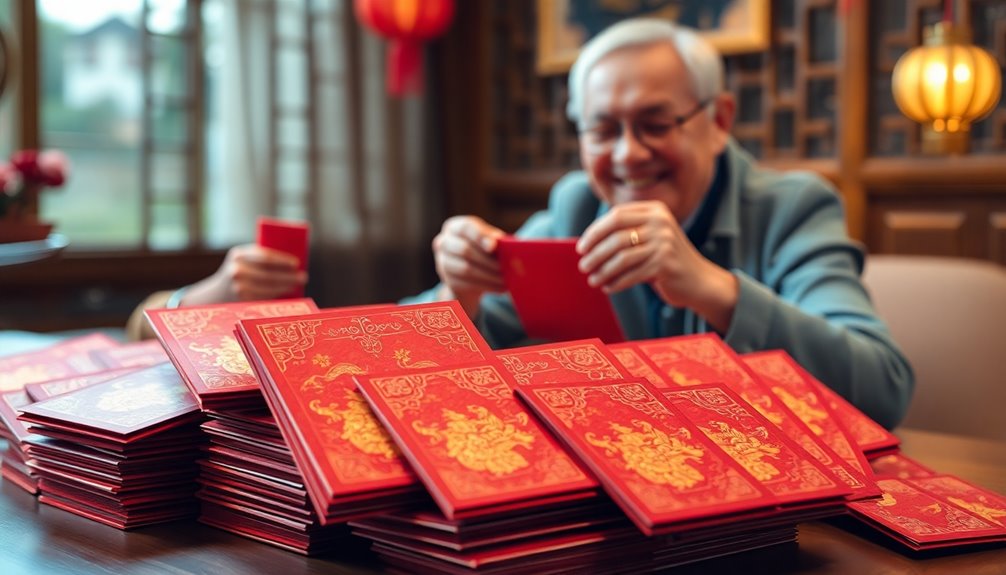
The origin of red packets, or hongbao, can be traced back thousands of years to ancient Chinese legends.
One prominent story involves the demon Sui, who frightened children during Chinese New Year. To ward off this evil spirit, families began using money wrapped in red paper, symbolizing good luck and prosperity.
This tradition has evolved over centuries, with the Han dynasty showcasing coins inscribed with auspicious words to repel evil.
By the Tang dynasty, elders started gifting money to children, sharing luck and fortune.
Today, modern red packets are typically filled with new, crisp banknotes, reinforcing the significance of the color red as a protector against misfortune and a harbinger of happiness during the festive season.
Cultural Significance
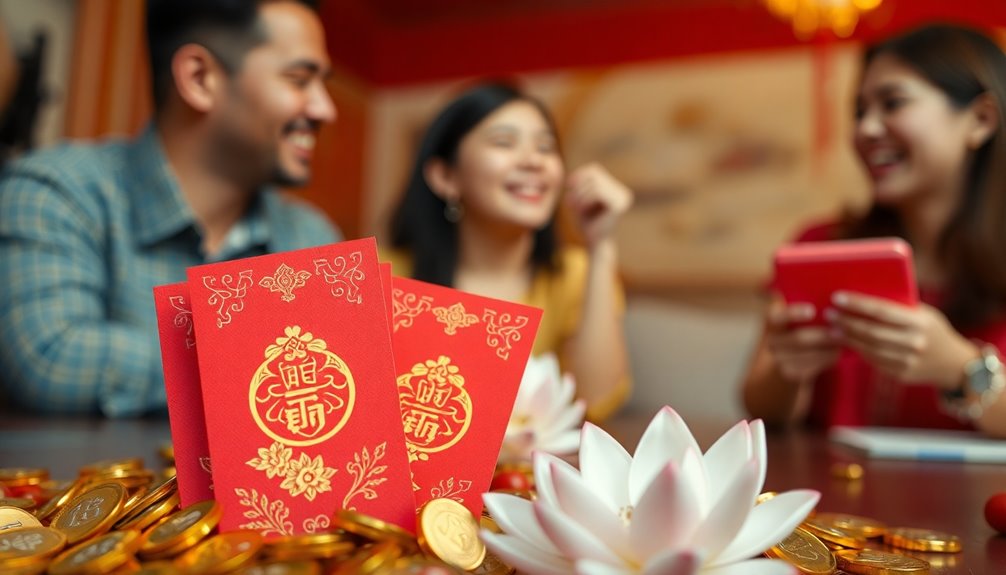
When you think about red packets, you'll see they carry deep cultural significance tied to good fortune and historical traditions.
These envelopes not only symbolize blessings but also represent a generational exchange that strengthens family bonds.
As you explore this rich practice, you'll uncover how it connects the past with modern celebrations.
Symbolism of Good Fortune
Red packets, or hongbao, embody the essence of good fortune in Chinese culture, especially during festive occasions like Chinese New Year.
These vibrant red envelopes symbolize blessings and prosperity, creating a joyful atmosphere during family gatherings. The tradition carries deep meaning, including:
- Protection against evil spirits, ensuring a safe and happy year ahead.
- The bright red color, representing happiness and wealth.
- The use of auspicious even-numbered amounts, which invite good luck.
- Reinforcement of family bonds, as hongbao are gifted to both children and elders.
Historical Origins of Tradition
Although many people enjoy receiving red packets during celebrations, few realize the deep historical roots of this cherished tradition.
The practice of giving red envelopes, or hongbao, dates back to the Han dynasty, where coins inscribed with auspicious characters were used to ward off evil spirits.
By the Tang dynasty, it evolved into a custom where elders gifted money to children during the New Year to repel malevolent forces. This money, known as yāsuì qián, translates to "money to ward off old age," emphasizing the protective intentions behind the tradition.
The bright red color of these envelopes symbolizes happiness and good fortune, reinforcing familial relationships while warding off evil, a practice rich in cultural significance and historical origins.
Generational Exchange Practices
As you explore the cultural significance of red packets, you'll find that they embody a rich tradition of generational exchange in Chinese society.
These red envelopes are more than just money; they symbolize blessings and good fortune passed from the older generation to the younger generation. This tradition fosters family bonds during the Lunar New Year and other celebrations.
Key aspects of this practice include:
- Older relatives giving red packets to children, wishing them safety.
- Married couples gifting packets during weddings to unmarried family members.
- Employers providing red packets to employees as tokens of gratitude.
- Family gatherings that reinforce connections and renew blessings for the coming year.
In essence, it's about giving money while nurturing traditions.
Who Receives Red Packets
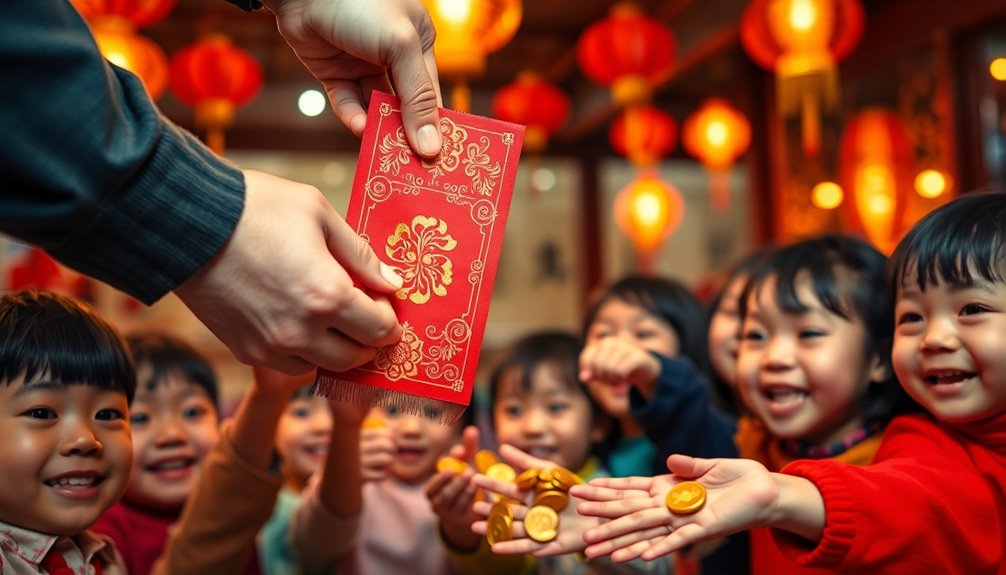
When celebrating festive occasions like Chinese New Year, younger, unmarried individuals, especially children, are the primary recipients of red packets, or hongbao. This tradition sees married couples, particularly older relatives, gifting these red envelopes to share blessings and good fortune.
In Hong Kong, it's common for couples to give two envelopes, while in Northern China and Taiwan, they often present one together. The joy of receiving red packets isn't limited to children; singles of all ages also participate in this custom during various celebrations.
Employers even join in by giving red packets as bonuses to employees before the Lunar New Year, ensuring that everyone feels included in this heartwarming tradition of generosity and good wishes.
Appropriate Amounts
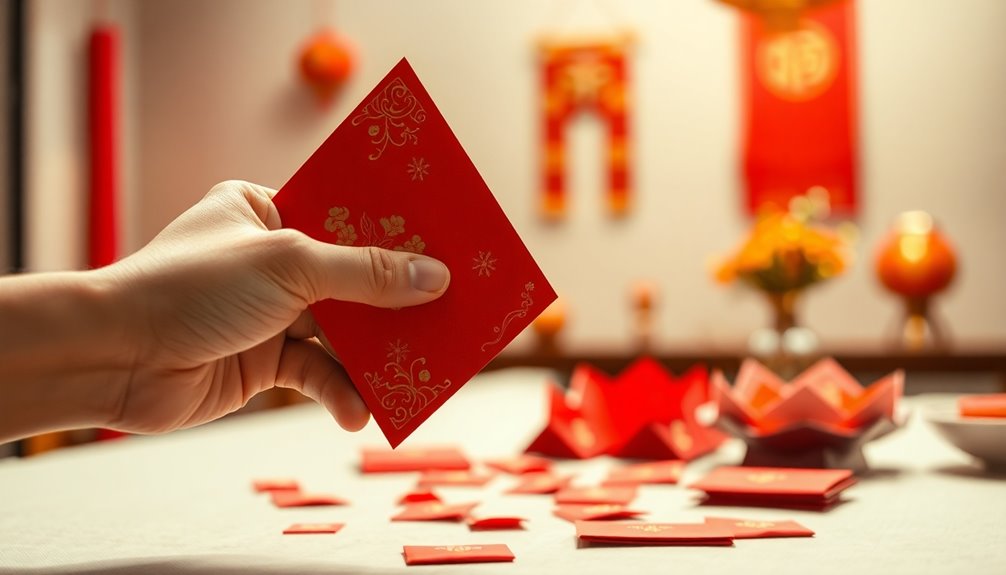
When you give a red packet, the amount you choose often reflects your relationship with the recipient.
For instance, children might receive at least 100 yuan, while elders could get much more, sometimes up to 2,000 yuan.
Plus, you'll want to take into account symbolic preferences, like avoiding amounts with the number 4, as it's linked to bad luck.
Relationship-Based Amounts
Amounts in red packets often reflect the closeness of the relationship between the giver and the recipient.
Here's how it typically breaks down:
- Children receive a minimum of 100 yuan ($20), representing luck and blessings.
- Young students might see amounts between 50–200 yuan ($10–30), acknowledging their educational journey.
- Employees often get between 100–1,000 yuan ($20–200), reflecting respect within the workplace's social hierarchy.
- Elders usually receive between 500–2,000 yuan ($100–300), honoring family bonds and their life experience.
These relationship-based amounts not only convey auspicious blessings during Chinese New Year but also highlight the giver's affection and respect for the recipient, making red envelopes a meaningful tradition.
Symbolic Numerical Preferences
The significance of red packets extends beyond just the relationship-based amounts; the numbers chosen also carry deep cultural meaning.
When you give red envelopes, consider the symbolic amounts you choose. Odd numbers are generally avoided, as they symbolize loneliness, while even numbers, especially 6s and 8s, are favored for their associations with good fortune. The number 4 is particularly inauspicious due to its similarity to the word for "death."
Popular denominations end in 0 or 6, reflecting auspicious traditions. During Chinese New Year, these monetary values not only express good wishes but also honor tradition.
Employers often treat red packets as annual bonuses, emphasizing their role in professional relationships and the importance of luck in monetary exchanges.
Giving and Receiving Etiquette

While giving a red envelope, it's important to use crisp, new bills, as this shows respect and good intentions.
Here are some key etiquette tips for giving and receiving red envelopes in Chinese culture:
- Always include money inside; an empty envelope is a no-go.
- Use even amounts, especially those ending in 6 or 8 for auspicious meanings.
- Recipients should accept red envelopes with both hands, expressing gratitude and respect.
- Open the envelope privately to maintain discretion and honor the gesture.
Modern Trends

As digital technology continues to evolve, red envelopes have embraced modernity, transforming from traditional paper gifts to convenient virtual ones.
Since WeChat introduced digital red envelopes in 2014, their popularity has skyrocketed, with over 32 billion virtual red envelopes sent during the 2016 Chinese New Year.
The ongoing "red envelope war" between WeChat and Alibaba fuels innovation, making these virtual gifts more engaging.
Younger generations particularly love the convenience of sending and receiving digital envelopes through mobile apps.
Alongside this trend, many are choosing eco-friendly options, like sustainable red envelope designs, to address environmental concerns.
Social media also plays a role, allowing you to share stories and traditions related to red envelopes, keeping the practice alive and relevant.
Variations Across Cultures
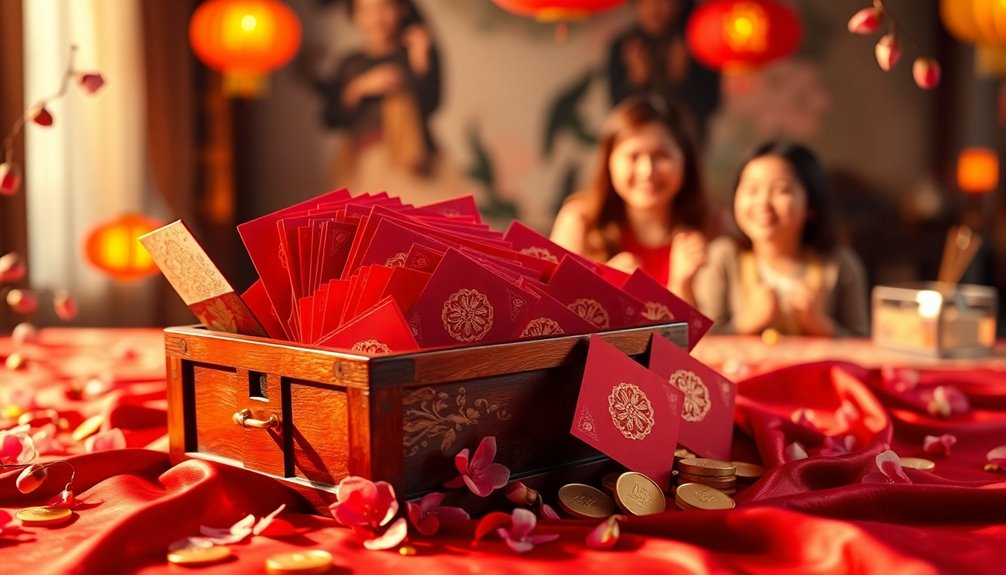
Red envelopes, symbolizing luck and prosperity, aren't unique to China; they appear in various forms across Asian cultures. You might find:
- Lì xì in Vietnam during Tết, given as a gift of money for good luck.
- Sampul duit raya in Malaysia and Indonesia, exchanged during Eid ul-Fitr, reflecting cultural significance.
- Ang pav in Cambodia, often tucked under pillows, containing monetary gifts to bring good fortune.
- Otoshidama in Japan, where children receive cash during New Year, strengthening familial bonds.
These variations showcase how the act of giving reflects shared values of prosperity and connection across cultures, emphasizing the importance of monetary gifts in celebrations. Additionally, similar themes of cultural significance in celebrations can be observed in various pet care traditions, highlighting the universal desire for luck and happiness in different contexts.
Frequently Asked Questions
Why Do Chinese Give Red Packets?
You might wonder why Chinese people give red packets. It's all about sharing good fortune and prosperity. When you receive one, it symbolizes blessings and is meant to ward off evil spirits.
Typically, these packets are given to younger, unmarried individuals by married couples or older relatives. The amounts often end in even numbers, which are considered lucky, while amounts with the number four are avoided because they're associated with bad luck.
Can You Give a Red Packet if You Are Not Married?
Yes, you can give a red packet even if you're not married!
While it's traditional for married individuals to give them, singles can still participate, especially during special occasions like weddings or to younger family members and friends.
It's all about sharing blessings and good fortune.
How Much Money Do You Get for the Red Envelope for Chinese New Year?
When you think about red envelopes, you might picture a child receiving a crisp 100 yuan alongside an elder who's delighted with 1,000 yuan. The amounts can vary considerably based on relationships and occasions.
As a young student, you might find 50 to 200 yuan waiting for you, while employees typically get bonuses ranging from 100 to 1,000 yuan.
It's all about celebrating connections and being considerate of your financial means.
What Does Picking up a Red Envelope Mean?
When you pick up a red envelope, it signifies your acceptance of good luck and blessings from the giver. This act connects you both and shows respect.
You should accept it with both hands and express gratitude, perhaps by saying something auspicious in return.
It's also polite to open the envelope privately, maintaining the personal nature of the gift.
This ritual reinforces cultural traditions and symbolizes sharing prosperity during festive occasions.
Conclusion
As you walk through a vibrant market during Lunar New Year, the red packets flutter like bright lanterns in the wind, each holding wishes for prosperity and fortune. They symbolize the warmth of connection, bridging generations with love and hope. When you give or receive one, you're not just exchanging money; you're partaking in a beautiful tapestry of culture and tradition. Embrace this ritual, and let the spirit of generosity illuminate your path throughout the year.









